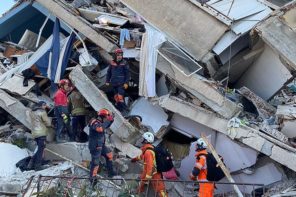Saudi Arabia has one of the largest humanitarian aid budgets in the world. It counts as an ‘emerging’ donor of substantial influence in one of the world’s most sever regions of crisis. At the same time, Saudi humanitarianism is commonly associated with religious indoctrination and the spread of an intolerant and misogynist version of Islam. The demonization of Saudi humanitarianism builds on an essentializing portrayal of a Saudi “Other” whose quest for cultural and political hegemony poses a threat. Few countries in the world continue to evoke associations of an exotic Other to the same extent as Saudi Arabia. Despite its place in the midst of globalization, deeply embedded in global economic, cultural and human flows, this modern state continues to be pictured as a “veiled kingdom”, associated with the desert, the bedouin, and women hidden from the gaze of “The West”.
Through the juxtaposition of the literature on Saudi overseas aid with local aid approaches in Saudi Arabia, I suggest that we should reconsider our understanding of Saudi humanitarianism. Rather than picturing Saudi humanitarian aid abroad as a comprehensive enterprise, driven by a monolithic state, I argue that Saudi humanitarianism is a contested field in which numerous actors compete and produce rather diverse results on the ground. For various methodological reasons, research on Saudi humanitarianism tends to focus either on overseas aid or on domestic aid practices, thus replicating an artificial demarcation which the Saudi state enforced in the wake of 9/11 and accusations that charitable funds support Islamist terrorists around the world. Yet, the concept of humanitarianism and the history of its associations in Saudi Arabia has been an organic one that does not easily follow clear divisions into a domestic and an overseas model.
What constitutes humanitarianism in the Saudi context?
In the Saudi context – as in the wider Arab and Islamic world (Moussa 2014, Benthall 2003) – humanitarianism includes at least three phenomena, which socio-cultural and political traditions of the Global North tend to picture as separate fields of engagement: emergency aid and relief, development assistance and charity. My research on charity in Saudi Arabia documents the diversity of local approaches that range from traditional almsgiving and food banks to sophisticated training programs, medical facilities and rehabilitation centers (Derbal 2014). Organizations like King Khaled Foundation in Riyadh and Majid Bin Abd al-Aziz Foundation in Jeddah aim to change the country’s contemporary philanthropic landscape, dismissing traditional notions of giving for their perceived lack of impact and efficiency, in favor of “sustainable development”, “capacity building” and “empowerment” (Matic & Al-Faisal 2012). Social entrepreneurship models have spread to Saudi Arabia through global initiatives like the highly popular Ashoka fellowship and INJAZ, which promote volunteerism and best practice solutions.
Rather than assuming a universal definition of humanitarianism, we should trace when and under which conditions these diverse activities have come to be represented in the language of humanitarianism.
I would argue that these shifts in representation point to important moments and shifts in (domestic) power constellations and (global) politics. The study of charitable practices in Saudi Arabia highlights the global place of the kingdom. It points to the receptiveness of Saudi society to global discourses and to the people from around the globe, who contribute to Saudi charity as consultants, invited speakers, role models, workers and volunteers. We can assume that the same is true for Saudi overseas aid, which is most often implemented in areas of crisis by non-Saudis, local partners and mediating organizations, whose agency in the everyday humanitarian encounter tends to be largely overlooked in the literature on Saudi overseas aid.
A multitude of actors rather than “the Saudis”
For decades, the Kingdom of Saudi Arabia has presented itself as a generous donor of international aid, headed by a unanimous royal family. The wish to produce (and control) one equally unanimous, comprehensive and coordinated vision of aid is reflected in the establishment of the King Salman Center for Relief and Humanitarian Aid (KSRelief), the central coordinating authority for overseas aid from Saudi Arabia established in 2015. Yet in reality, Saudi humanitarianism is offered and coordinated through a multitude of actors (El Taraboulsi 2017). Efforts include bilateral and multilateral aid through regional and international bodies, public campaigns, foundations by individual royals, and other private donors. The line between public and private, state and individual engagement is frequently blurred.
Although the royal family often manages to prevent internal dissent to leak to the public, fractions among members of the Al Saʿud persist and disagreement among top royals occasionally becomes visible. Rumors suggest that Crown Prince Mohammad bin Salman seized power in July 2017 in a palace coup, ousting his cousin Mohammad bin Nayef, until then dedicated heir to the throne and Minister of Interior. An extraordinary public power play occurred in November 2017, when King Salman decreed the arrest of eleven senior princes, four ministers and dozens of other government officials, who became prisoners at the five-star Ritz Carlton Hotel in Riyadh. One of the hotel prisoners was the billionaire Prince Alwaleed bin Talal, who is one of the most visible Saudi humanitarian actors and founder of Alwaleed Philanthropies. Prince Alwaleed’s father, Talal bin Abd al-Aziz, was the president of the Arab Gulf Program for Development (Ag-Fund). His “Free Princes” movement was one of the strongest proponents of a constitutional monarchy in the history of Saudi Arabia. In short, rather than assuming that Saudi humanitarianism reflects one national vision, we can imagine that competing royals translate their differences onto the humanitarian field.
Moving beyond the Saudi “Other” and religious extremism
When does building a school serve capacity building and empowerment and when does it serve indoctrination? Building schools, wells and mosques count among the most publicized achievements of Saud humanitarianism. The mosque serves many communities in need as an important meeting space that offers hope in times of hardship but also fosters networks of self-help (Benthall 2012). Wells satisfy essential human needs but might also be interpreted to allow for ablution before Islamic prayer. Only a close look at a school’s curricula, teaching practices and personnel, as well as the wider activities that take place at the particular site allow to assess the impact on its pupils.
The study of charitable practices in Saudi Arabia highlights flexibility in interpretation and the adaptability of religious doctrine in contrast to ideals proclaimed in the self-presentations of donors and agencies.
My own research shows how religious regulations stipulated, for instance, in the Quran regarding the legitimate beneficiaries of alms (Quran 9:60) have been reinterpreted by religious authorities in Saudi Arabia through religious edicts (fatwas) that allow organizations to spend zakat on medical services for rural communities. Yet, so far very little empirically-driven research has turned to the actual situation on the ground.
Gaining trust and access to sites of humanitarian practice is often challenging, yet imperative to understand the diversity and complexity of the humanitarian field. In the course of my research on domestic charitable practice in Saudi Arabia I encountered a broad range of different visions of community engagement, gathered under the umbrella of charity. Humanitarianism has offered a niche for my interlocutors in Jeddah and Riyadh, who sought to make a positive change. However, what constitutes “positive change” is a highly contested topic in today’s Saudi Arabia.
References
Benthall, Jonathan, and Jerome Bellion-Jourdan. Charitable Crescent: Politics of Aid in the Muslim World. London; New York: I.B. Tauris, 2003.
Benthall, Jonathan. “‘Cultural Proximity’ and the Conjuncture of Islam with Modern Humanitarianism.” In Sacred Aid: Faith and Humanitarianism, 65–89. Oxford; New York: Oxford University Press, 2012.
Derbal, Nora. “Domestic, Religious, Civic? Notes on the Institutionalized Charitable Field in Jeddah, Saudi Arabia.” In Gulf Charities and Islamic Philanthropy in the “Age of Terror” and Beyond, edited by Robert Lacey and Jonathan Benthall, 145–68. Berlin: Gerlach Press, 2014.
El Taraboulsi-McCarthy, Sherine. “A Kingdom of Humanity? Saudi Arabia’s Values, Systems and Interests in Humanitarian Action.” HPG Working Paper. London: Humanitarian Policy Group, Overseas Development Institute, 2017. https://www.odi.org/sites/odi.org.uk/files/resource-documents/11741.pdf.
Matic, Natasha M., and Banderi A. R. Al-Faiṣal. “Empowering the Saudi Social Development Sector.” The Fletcher Forum of World Affairs 36, no. 2 (2012): 11–18.
Moussa, Jasmine. “Ancient Origins, Modern Actors: Defining Arabic Meanings of Humanitarianism.” HPG Working Paper. Overseas Development Institute: Humanitarian Policy Group, November 2014.
Featured image by Stephen Downes (flickr, CC BY-NC 2.0)








